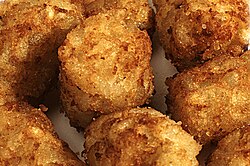Tater tots
 Tater tots
Tater totsTater tots are pieces of deep-fried, grated potatoes served as a side dish. They are recognized for their cylindrical shape and crispy exterior. "Tater Tots" is a registered trademark of Ore-Ida (a division of the H. J. Heinz Company) that is often used as a generic term.
The product was created in 1953 when Ore-Ida founders F. Nephi Grigg and Golden Grigg were trying to figure out what to do with leftover slivers of cut-up potatoes. They chopped up the slivers, added flour and seasoning, then pushed the mash through holes and sliced off pieces of the extruded mixture. The product was first offered in stores in 1956.
Originally, the product was very inexpensive. According to advertising lectures at Iowa State University, people did not buy it at first because there was no perceived value. When the price was raised, people began buying it. Today, Americans consume approximately 70 million pounds of tater tots per year.
"Tater" is an abbreviation of potato (origin: 1750–60; America; by apheresis, "tato", an alternate spelling of neutral vowel, "tater"); "Tots" may have been derived from their diminutive size, or because they are often served to children. In some regions, the term "tater" is dropped, and the snack is informally called "tots".
In the United States, tater tots are common at school-lunch counters and cafeterias. They are also sold in the frozen food sections of grocery stores. Some fast-food restaurants also offer them.
The supermarket chain Safeway Inc. sells a generic brand of tater tots known as "Tater Treats". Sonic drive-in also features tater tots on their regular menu; available toppings include cheese and chili. Sonic also sells "Cheesy Tots", coin-shaped tots that contain melted cheese and potatoes. Several restaurants in the Pacific Northwest offer a nacho version of tots ("totchos"), covered in nacho cheese sauce and toppings.
...
Wikipedia